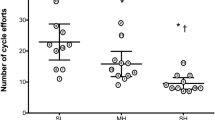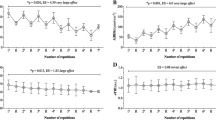Abstract
Purpose
The present study was performed to determine the impact of hypoxia on working muscle oxygenation during incremental running, and to compare tissue oxygenation between the thigh and calf muscles.
Methods
Nine distance runners and triathletes performed incremental running tests to exhaustion under normoxic and hypoxic conditions (fraction of inspired oxygen = 0.15). Peak pulmonary oxygen uptake (\({\dot{\text{V}}\text{O}}_{{ 2 {\text{peak}}}}\)) and tissue oxygen saturation (StO2) were measured simultaneously in both the vastus lateralis and medial gastrocnemius.
Results
Hypoxia significantly decreased peak running speed and \({\dot{\text{V}}\text{O}}_{{ 2 {\text{peak}}}}\) (p < 0.01). During incremental running, StO2 in the vastus lateralis decreased almost linearly, and the rate of decrease from warm-up (180 m min−1) to \({\dot{\text{V}}\text{O}}_{{ 2 {\text{peak}}}}\) was significantly greater than in the medial gastrocnemius under both normoxic and hypoxic conditions (p < 0.01). StO2 in both muscles was significantly decreased under hypoxic compared with normoxic conditions at all running speeds (p < 0.01). The rate at which StO2 was decreased by hypoxia was greater in the vastus lateralis as the running speed increased, whereas it changed little in the medial gastrocnemius.
Conclusions
These results suggest that the thigh is more deoxygenated than the calf under hypoxic conditions, and that the effects of hypoxia on tissue oxygenation differ between these two muscles during incremental running.




Similar content being viewed by others
Abbreviations
- FIO2 :
-
Fraction of inspired oxygen fraction
- Hb:
-
Hemoglobin
- HHb:
-
Deoxygenated hemoglobin and myoglobin
- NIRS:
-
Near infrared spectroscopy
- O2Hb:
-
Oxygenated hemoglobin and myoglobin
- SD:
-
Standard division
- SpO2 :
-
Arterial oxygen saturation
- StO2 :
-
Tissue oxygen saturation
- \({\dot{\text{V}}\text{O}}_{ 2}\) :
-
Oxygen uptake
- \({\dot{\text{V}}\text{O}}_{{ 2 {\text{peak}}}}\) :
-
Peak oxygen uptake
References
Bhambhani Y (2012) Application of near infrared spectroscopy in evaluating cerebral and muscle haemodynamics during exercise and sport. J Near Infrared Spectrosc 20:117–139
Bijker KE, de Groot G, Hollander AP (2002) Differences in leg muscle activity during running and cycling in humans. Eur J Appl Physiol 87:556–561
Boone J, Barstow TJ, Celie B, Prieur F, Bourgois J (2015) The impact of pedal rate on muscle oxygenation, muscle activation and whole-body VO2 during ramp exercise in healthy subjects. Eur J Appl Physiol 115:57–70
Boone J, Vandekerckhove K, Coomans I, Prieur F, Bourgois JG (2016) An integrated view on the oxygenation responses to incremental exercise at the brain, the locomotor and respiratory muscles. Eur J Appl Physiol 116:2085–2102
Bourdillon N, Mollard P, Letournel M, Beaudry M, Richalet JP (2009) Non-invasive evaluation of the capillary recruitment in the human muscle during exercise in hypoxia. Respir Physiol Neurobiol 165:237–244
Bowtell JL, Cooke K, Turner R, Mileva KN, Sumners DP (2014) Acute physiological and performance responses to repeated sprints in varying degrees of hypoxia. J Sci Med Sport 17:399–403
Cannon DT, Howe FA, Whipp BJ, Ward SA, McIntyre DJ, Ladroue C, Griffiths JR, Kemp GJ, Rossiter HB (2013) Muscle metabolism and activation heterogeneity by combined 31P chemical shift and T2 imaging, and pulmonary O2 uptake during incremental knee-extensor exercise. J Appl Physiol 115:839–849
Chin LM, Kowalchuk JM, Barstow TJ, Kondo N, Amano T, Shiojiri T, Koga S (2011) The relationship between muscle deoxygenation and activation in different muscles of the quadriceps during cycle ramp exercise. J Appl Physiol 111:1259–1265
Collins MH, Pearsall DJ, Zavorsky GS, Bateni H, Turcotte RA, Montgomery DL (2000) Acute effects of intense interval training on running mechanics. J Sports Sci 18:83–90
Day JR, Rossiter HB, Coats EM, Skasick A, Whipp BJ (2003) The maximally attainable VO2 during exercise in humans: the peak vs. maximum issue. J Appl Physiol 95:1901–1907
DeLorey DS, Shaw CN, Shoemaker JK, Kowalchuk JM, Paterson DH (2004) The effect of hypoxia on pulmonary O2 uptake, leg blood flow and muscle deoxygenation during single-leg knee extension exercise. Exp Physiol 89:293–302
Fontana FY, Keir DA, Bellotti C, De Roia GF, Murias JM, Pogliaghi S (2015) Determination of respiratory compensation point in healthy adults: can non-invasive near-infrared spectroscopy help? J Sci Med Sport 18:590–595
Fujimoto T, Itoh M, Tashiro M, Yamaguchi K, Kubota K, Ohmori H (2000) Glucose uptake by individual skeletal muscles during running using whole-body positron emission tomography. Eur J Appl Physiol 83:297–302
Grassi B, Quaresima V (2016) Near-infrared spectroscopy and skeletal muscle oxidative function in vivo in health and disease: a review from an exercise physiology perspective. J Biomed Opt 21:091313
Grassi B, Quaresima V, Marconi C, Ferrari M, Cerretelli P (1999) Blood lactate accumulation and muscle deoxygenation during incremental exercise. J Appl Physiol 87:348–355
Hamaoka T, McCully KK, Quaresima V, Yamamoto K, Chance B (2007) Near-infrared spectroscopy/imaging for monitoring muscle oxygenation and oxidative metabolism in healthy and diseased humans. J Biomed Opt 12:062105
Hansen J, Sander M, Hald CF, Victor RG, Thomas GD (2000) Metabolic modulation of sympathetic vasoconstriction in human skeletal muscle: role of tissue hypoxia. J Physiol 527:387–396
Heinonen IH, Kemppainen J, Kaskinoro K, Peltonen JE, Borra R, Lindroos M, Oikonen V, Nuutila P, Knuuti J, Boushel R, Kalliokoski KK (2010) Regulation of human skeletal muscle perfusion and its heterogeneity during exercise in moderate hypoxia. Am J Physiol Regul Integr Comp Physiol 299:R72–R79
Hiroyuki H, Hamaoka T, Sako T, Nishio S, Kime R, Murakami M, Katsumura T (2002) Oxygenation in vastus lateralis and lateral head of gastrocnemius during treadmill walking and running in humans. Eur J Appl Physiol 87:343–349
Hug F, Bendahan D, Le Fur Y, Cozzone PJ, Grelot L (2004) Heterogeneity of muscle recruitment pattern during pedaling in professional road cyclists: a magnetic resonance imaging and electromyography study. Eur J Appl Physiol 92:334–342
Johnson MA, Polgar J, Weightman D, Appleton D (1973) Data on the distribution of fiber types in thirty-six human muscles: an autopsy study. J Neurol Sci 18:111–129
Jones AM, Doust JH (1996) A 1% treadmill grade most accurately reflects the energetic cost of outdoor running. J Sports Sci 14:321–327
Keir DA, Fontana FY, Robertson TC, Murias JM, Paterson DH, Kowalchuk J, Pogliaghi S (2015) Exercise intensity thresholds: identifying the boundaries of sustainable performance. Med Sci Sports Exerc 47:1932–1940
Kime R, Niwayama M, Fujioka M, Shiroishi K, Osawa T, Shimomura K, Osada T, Murase N, Katsumura T (2010) Unchanged muscle deoxygenation heterogeneity during bicycle exercise after 6 weeks of endurance training. Adv Exp Med Biol 662:353–358
Krssak M, Petersen KF, Bergeron R, Price T, Laurent D, Rothman DL, Roden M, Gin Shulman (2000) Intramuscular glycogen and intramyocellular lipid utilization during prolonged exercise and recovery in man: a 13C and 1H nuclear magnetic resonance spectroscopy study. J Clin Endocrinol Metab 85:748–754
McDonough P, Behnke BJ, Padilla DJ, Musch TI, Poole DC (2005) Control of microvascular oxygen pressures in rat muscles comprised of different fibre types. J Physiol 563:903–913
Miyachi M, Tabata I (1992) Relationship between arterial oxygen desaturation and ventilation during maximal exercise. J Appl Physiol 73:2588–2591
Moritani T, Sherman WM, Shibata M, Matsumoto T, Shinohara M (1992) Oxygen availability and motor unit activity in humans. Eur J Appl Physiol Occup Physiol 64:552–556
Niwayama M, Sone S, Murata H, Yoshida H, Shinohara S (2007) Errors in muscle oxygenation measurement using spatially-resolved NIRS and its correction (in Japanese). J Jpn Coll Angiol 47:17–20
Novacheck TF (1998) The biomechanics of running. Gait Posture 7:77–95
Ogawa T, Hayashi K, Ichinose M, Nishiyasu T (2007) Relationship between resting ventilatory chemosensitivity and maximal oxygen uptake in moderate hypobaric hypoxia. J Appl Physiol 103:1221–1226
Ogita F, Tabata I (1992) Oxygen uptake during swimming in a hypobaric hypoxic environment. Eur J Appl Physiol Occup Physiol 65:192–196
Osawa T, Kime R, Hamaoka T, Katsumura T, Yamamoto M (2011) Attenuation of muscle deoxygenation precedes EMG threshold in normoxia and hypoxia. Med Sci Sports Exerc 43:1406–1413
Peltonen JE, Rantamäki J, Niittymäki SP, Sweins K, Viitasalo JT, Rusko HK (1995) Effects of oxygen fraction in inspired air on rowing performance. Med Sci Sports Exerc 27:573–579
Quaresima V, Komiyama T, Ferrari M (2002) Differences in oxygen re-saturation of thigh and calf muscles after two treadmill stress tests. Comp Biochem Physiol A Mol Integr Physiol 132:67–73
Rådegran G, Hellsten Y (2000) Adenosine and nitric oxide in exercise-induced human skeletal muscle vasodilatation. Acta Physiol Scand 168:575–591
Saito M, Mano T, Iwase S, Koga K, Abe H, Yamazaki Y (1988) Responses in muscle sympathetic activity to acute hypoxia in humans. J Appl Physiol 65:1548–1552
Simpson KJ, Bates BT (1990) The effects of running speed on lower extremity joint moments generated during the support phase. Int J Sport Biomech 6:309–324
Spencer MD, Murias JM, Grey TM, Paterson DH (2012a) Regulation of VO2 kinetics by O2 delivery: insights from acute hypoxia and heavy-intensity priming exercise in young men. J Appl Physiol 112:1023–1032
Spencer MD, Murias J, Paterson DH (2012b) Characterizing the profile of muscle deoxygenation during ramp incremental exercise in young men. Eur J Appl Physiol 112:3349–3360
Subudhi AW, Dimmen AC, Roach RC (2007) Effects of acute hypoxia on cerebral and muscle oxygenation during incremental exercise. J Appl Physiol 103:177–183
Vogiatzis I, Habazettl H, Louvaris Z, Andrianopoulos V, Wagner H, Zakynthinos S, Wagner PD (2015) A method for assessing heterogeneity of blood flow and metabolism in exercising normal human muscle by near-infrared spectroscopy. J Appl Physiol 118:783–793
Wadley GD, Lee-Young RS, Canny BJ, Wasuntarawat C, Chen ZP, Hargreaves M, Kemp BE, McConell GK (2006) Effect of exercise intensity and hypoxia on skeletal muscle AMPK signaling and substrate metabolism in humans. Am J Physiol Endocrinol Metab 290:E694–E702
Wang L, Yoshikawa T, Hara T, Nakao H, Suzuki T, Fujimoto S (2006) Which common NIRS variable reflects muscle estimated lactate threshold most closely? Appl Physiol Nutr Metab 31:612–620
Zavorsky GS, Montgomery DL, Pearsall DJ (1998) Effect of intense interval workouts on running economy using three recovery durations. Eur J Appl Physiol Occup Physiol 77:224–230
Acknowledgements
We would like to express our gratitude to the subjects in this study. This study was supported by a Grant-in-Aid for Research Activity Start-up (23800075) from the Japan Society for the Promotion of Science (JSPS).
Author information
Authors and Affiliations
Corresponding author
Ethics declarations
Conflict of interest
This study was performed without any conflict of interest, financial or otherwise.
Additional information
Communicated by I. Mark Olfert.
Rights and permissions
About this article
Cite this article
Osawa, T., Arimitsu, T. & Takahashi, H. Hypoxia affects tissue oxygenation differently in the thigh and calf muscles during incremental running. Eur J Appl Physiol 117, 2057–2064 (2017). https://doi.org/10.1007/s00421-017-3696-8
Received:
Accepted:
Published:
Issue Date:
DOI: https://doi.org/10.1007/s00421-017-3696-8




